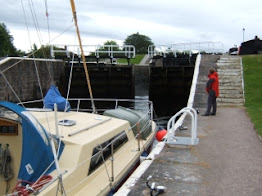Saturday, June 27, 2009
Colours
Monday, June 22, 2009
Loch Solitude
Wednesday, June 17, 2009
The Great Glen
Such statistics are truly sobering here on Cirrus, moored on its surface as night falls. The steep sides of the Great Glen divert sudden gusts of wind down on us from the mountains around (sailors call these 'williwaws') although we are safe enough tucked into a little cove nearly half way along the loch's 26 miles length and surrounded by a tree-lined shore.
Our first view of the Great Glen came as we sailed west out of the Moray Firth towards Inverness.
Mysteriously it was as if the sky also divided, reflecting the land beneath. Our boat then had to raise itself to the level of Loch Ness through a series of locks, one a flight of four coupled together, great edifices of stone designed by Thomas Telford who also had a hand in many of the harbours we have been visiting over the last few weeks.
Where, you might ask, are the photos of this encounter. And likewise where are the photos of the dolphins which swam towards us as we approached and left Burghead harbour, big beasts coming close enough to look us straight in the eye from just beneath our bow.
Saturday, June 13, 2009
Risk junkies?
The answer to this lies not so much in what we do but more in where we do it. Take a recent Sunday cycling adventure, for example, where we found ourselves first of all traversing a busy golf course when members were queuing at each hole for the chance to score a direct hit on a cyclist then, having survived this, we crossed a main railway line and found ourselves on a cycle route past a military firing range with red flags flying and signs warning graphically "Anything you pick up may explode and kill you".
Or again, take a recent walk along the Seaton cliffs just outside Arbroath where the sea has shaped the Devonian sandstone into formations with names like the "Deil's Heid" or this one, the "Needle E'e". Warning signs here show just what happened to this foolish Johnny who strayed from the path and had to be rescued.
Clearly this is also a risky place to be and once again we have found the excitement we need to survive.
No such additional buzz was needed when we sailed around Rattray Head earlier today. This will be our most northerly headland on this trip and it has a fearsome reputation, more than anywhere we have previously sailed. The coastline is low-lying here and only a small stunted lighthouse guards what is one of the major corners of Britain. The tidal currents rushing past flow over off-lying shoals and can combine with strong winds to produce nightmares of turbulence that can swallow ships whole.
But pick the right weather and get up at 4.30am as we did to catch the tide at the moment it goes slack and you can sail benignly past and into the Moray Firth.
Our cockpit GPS chartplotter and log now show we have turned this corner, at 5.5 knots, and are now at last on course towards the Great Glen, the passage to the west coast of Britain.
Saturday, June 6, 2009
Chasing the seasons
Spring this far north comes late, but when it does come it is all of a rush and the colours are rendered shockingly clear in the unpolluted air.
Mere photographs do not do justice to the feast nature puts on for us but I try to capture the smallest detail, even this bee in mid flight between flowers of the Viper's Bugloss (nice photo eh?).
It is our first visit to Arbroath and like many other harbours we enter from the sea not knowing what we will find inside. It is not a natural harbour, but is a small area captured from the sea many centuries ago and now protected by walls of grey stone and concrete. We motor carefully through a narrow channel in the off-lying rocks guided by two white posts set one in front of the other, leading marks, past the tough looking white-painted entrance, make a sharp right turn around a harbour wall then left again into the tiny inner harbour. There is a call of welcome from a boiler-suited harbour master, "Ah, two hulls!" (catamarans are not a common sight here) and he directs us to a pontoon berth just ahead. Immediately we feel at home in this world of fisher folk. This harbour has embraced the new prosperity offered by us pleasure boaters and we are surrounded by masts and clacking halyards on fibreglass yachts; the old has come to terms with the new.
The picture here, I hasten to add, is of Edinburgh's rock-bound castle, not of the convenience that lies within.
Monday, June 1, 2009
Firth of Forth
yacht when, in August 1986 we were the subject of one of the last SOS messages broadcast on Radio 4.
Meanwhile out on Bass Rock life goes on for the thousands of Gannets forever swirling in white clouds over the island. The white cap makes the rock stand out from its neighbours (white being the colour of both the birds and their droppings, such that it is difficult to distinguish one from the other) making it visible from many miles away on a clear day. Unlike 23 years ago, this time it was a fabulous day and we sailed the inside passage, between the rock and the North Berwick shore, in glorious sunshine, surfing down waves in a red boat just as we did then.





















